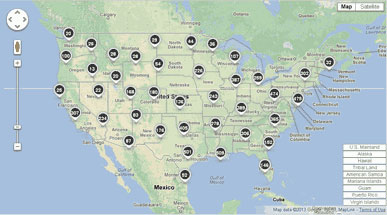Today, the US Environmental Protection Agency (EPA) announced its second try at carbon regulations for new power plants, after going back to the drawing board last year.
These would be the first rules that address carbon dioxide as a pollutant – ordered by the Supreme Court years ago under the Clean Air Act, but since then the subject of endless lawsuits and legislation from the fossil fuel lobby – all of which EPA won. The fight now begins again.
EPA’s proposed rules only limit carbon pollution from new power plants – rules for existing power plants, which are way more important, come out by next June.
Under the rules, new coal plants can’t emit more than 1100 pounds of carbon per megawatt-hour (MWh), which would require widely available carbon capture technology. They have the option of meeting somewhat tighter limits if they choose to average emissions over multiple years, giving them more operational flexibility. Typical plants currently emit 1,800 pounds per MWh, which would be cut in half using pollution prevention technology.
New large natural gas-fired plants are limited to emitting 1,000 pounds of carbon per MWh and small plants have a 1100 pound limit. The cap actually exceeds what typical plants emit – about 800 pounds per MWh.
All these standards do is ensure that new power plants are built with current best technology, the same requirement for all industries except the power sector – which produces 40% of US carbon emissions, the nation’s biggest source. Plants can even phase in technologies, says EPA.
While the EPA places limits on emissions of arsenic, mercury and lead – which have resulted in closures of coal plants – there are currently no national limits on the amount of carbon pollution new power plants can emit.
Believe it or not, US coal plants produce more emissions than most countries do. Once built, they’re in service for about 50 years, so building just one inefficient, emissions-intensive plant locks us into millions of tons of future climate pollution.
Just five new coal plants like the one recently built in Texas would discharge enough emissions over its lifetime to entirely offset the emission savings from Clean Cars Standards of 54 miles per gallon.
But few new coal plants are expected to be built in the future with or without these rules because of natural gas prices, giving this regulation very limited impact on addressing climate change.
You can find the biggest polluters on EPA’s website.

The standards are similar to clean air standards adopted by California, Oregon, New York, Montana, Minnesota, New Mexico and Washington State.
The rules give power companies the certainty they need to invest in cleaner power plants. Many utilities have been holding off investing because of this uncertainty.
22 major corporations sent a letter to President Obama, supporting the regulations. "As businesses concerned about the immediate and long term implications of climate change, we are pleased to see the EPA issue this proposed rule today," it says.
"The new standards will reinforce what forward-looking companies already know: that climate change poses real financial risks and opportunities and that the future of the electric power sector depends on investing in cleaner technologies and more efficient resources – investments that create jobs and economic benefits."
Signatories are: Unilever, Levi Strauss, Patagonia, Symantec, Acer, Akami Technologies, Annie’s Homegrown, Ben & Jerry’s, Stonyfield Farm, The North Face, Dignity Health, Eastern Bank, K2 Sports, L’Oreal, Method, New Belgium Brewing, Portland Trail Blazers, Saunders Hotel Group, Seventh Generation, Timberland, United Natural Foods and Aspen Skiing Company.
Regulating Existing Power Plants Come Next
EPA says its rules for existing power plants will not require carbon capture.
"Carbon capture is really effective as a tool to reduce emissions when it’s designed with the facility itself," says EPA Administrator Gina McCarthy. Instead of focusing on limiting emissions at particular plants, the EPA plans a very different process – "one that requires that EPA has a broader discussion about how states can reduce carbon."
EPA could, for example, set emission caps on power sector as a whole and let states decide how they will meet them. They could boost energy efficiency and renewables to lower total emissions, which might require less stringent regulations on existing power plants.
The five most polluting power plants are:
- Georgia Power: Plant Scherer (Georgia)
- Alabama Power Co.: James H. Miller Jr. Plant (Alabama)
- Luminant: Martin Lake (Texas)
- Ameren: Labadie (Missouri)
- NRG Energy: WA Parish (Texas)
Read our article, Who Are the Top Polluters of Air, Water & Climate in the US?
and US Air Pollution Also a Major Problem.
The comment period now begins and is open for 60 days. Learn more and comment:
